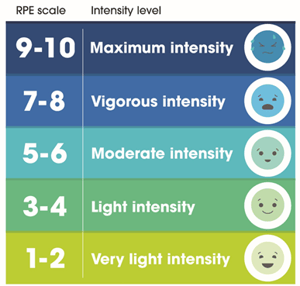What is it?
Rate of Perceived Exertion (RPE) is a measure of how hard you are working when you are moving your body. It includes:
- how fast your heart is beating.
- how out of breath you are.
- how tired your muscles feel.
- how much you are sweating.
Why is it important?
It helps:
- note progress in how hard and how long you are moving your body.
- increase exercise safely to avoid overworking your body.
- provide a guideline for trying to add in the advised workouts into your life.
How is RPE measured?
RPE is measured on a scale from 1 to 10. Here are examples of how your body may feel:
- 1 to 2: Very light intensity
- You can talk and breathe normally.
- 3 to 4: Light intensity
- Talking is fine. You can move with little effort.It is easy to keep moving.
- 5 to 6: Moderate intensity
- You can talk but not sing. You are breathing more quickly.
- 7 to 8: Vigorous intensity
- You can say a few words at a time. It is getting hard to keep moving.
- 9 to 10: Maximum intensity
- You cannot talk. You are out of breath. You want to stop moving.
How else can I measure my child’s effort?
Another way to measure how hard your child is working while moving their body is with a simple test called a talk test. The easier it is to talk, the less intense the activity is.
- At moderate intensity, you can talk but not sing.
- At high intensity, you can only say a few words without pausing for a breath.
- For example, have your child say the ABC’s when they are moving. Was it easy or hard?
What intensity is recommended?
The American Heart Association advises children ages 6 to17 years old to do:
- moderate to high intensity workouts (levels 5 to10) for 1 hour every day.
- high intensity workouts (levels 7 to10) at least 3 days per week.



